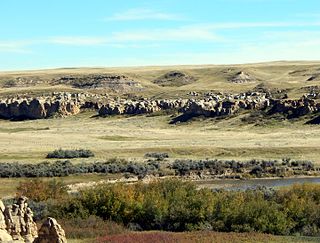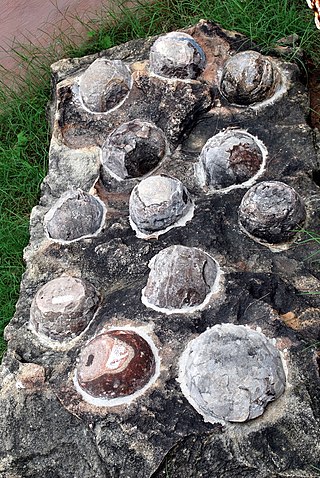
Milk River is a town in Alberta, Canada that is named after the Milk River which flows immediately to its south. This location results in Milk River being one of the few Canadian communities within the Mississippi River drainage system. It is 70 kilometres (43 mi) south of Lethbridge, and 16 kilometres (9.9 mi) from the Canada–United States border. It is primarily a service centre for the many farms and cattle ranches which surround it.

The Indroda Dinosaur and Fossil Park in Gandhinagar, Gujarat, India, is a park that houses fossilized remains and petrified eggs of dinosaurs. It is a man-made fossil park and not the actual nesting grounds where the dinosaurs lived. The eggs and fossils on display here are from the world's 3rd-largest dinosaur fossil excavation site and 2nd-largest hatchery at Raiyoli, Balasinor, Gujarat. The Park was set up by the Geological Survey of India and is the only dinosaur museum in the country.

Stirling is a village in southern Alberta, Canada that is surrounded by the County of Warner No. 5. The village is located on Highway 4, approximately 31 km (19 mi) southeast of Lethbridge and 72 km (45 mi) northwest of the Canada–US border.
Warner is a village in Alberta, Canada. It is surrounded by the County of Warner No. 5, approximately 65 km (40 mi) south of Lethbridge. Warner is a farming community. Warner is situated at the intersection of Highway 4 and Highway 36, about 38 km north of the Montana border and Interstate 15. Warner's nearest neighbours are the towns of Stirling and Milk River.
The Oldman Formation is a stratigraphic unit of Late Cretaceous age that underlies much of southern Alberta, Canada. It consists primarily of sandstones that were deposited in fluvial channel and floodplain environments. It was named for exposures along the Oldman River between its confluence with the St. Mary River and the city of Lethbridge, and it is known primarily for its dinosaur remains and other fossils.

The County of Warner No. 5 is a municipal district in southern Alberta, Canada. Located in Census Division No. 2 just north of the United States border, its municipal office is located in the Village of Warner.

Horseshoe Canyon is a region of badlands surrounded by prairie in the province of Alberta, Canada. It is located about 17 km (11 mi) west of the town of Drumheller, Alberta, along Highway 9.
Conrad is a former unincorporated community in the County of Warner No. 5, Alberta, Canada. The population of the community was fairly small and only had around 5 people with two grain elevators. Today nothing remains of the community, but its original location on the historic Red Coat Trail was 8 km (4 mi) east of the Hamlet of Wrentham and about 24 km (14 mi) west of the Village of Foremost. The community was named by the Canadian Pacific Railway.
Lucky Strike is a locality in the County of Warner No. 5, Alberta, Canada located on Highway 501, approximately 26 km (16 mi) east of the Town of Milk River and 18 km (11 mi) south of the Village of Foremost.

The Foremost Formation is a stratigraphic unit of Late Cretaceous (Campanian) age that underlies much of southern Alberta, Canada. It was named for outcrops in Chin Coulee near the town of Foremost and is known primarily for its dinosaur remains and other fossils.

Dinosaur reproduction was relevant to archosaur physiology, with newborns hatching from eggs. Dinosaurs did not nurture their offspring as mammals typically do, and because dinosaurs did not nurse, it is likely that most dinosaurs were capable of surviving on their own after hatching.
Judson is a former unincorporated community in southern Alberta, Canada within the County of Warner No. 5. It is located on Highway 61 between the villages of Stirling and Wrentham, approximately 45 kilometres (28 mi) southeast of the City of Lethbridge.
Craddock is a former unincorporated community in southern Alberta, Canada within the County of Warner No. 5. It is located between the Village of Stirling and the Hamlet of New Dayton, approximately 30 kilometres (19 mi) southeast of the City of Lethbridge on Highway 4.
McNab is a former unincorporated community in southern Alberta, Canada within the County of Warner No. 5. It is located on Highway 506 between the Hamlet of New Dayton and the Village of Warner, approximately 50 kilometres (31 mi) southeast of the City of Lethbridge.
Continuoolithus is an oogenus of dinosaur egg found in the late Cretaceous of North America. It is most commonly known from the late Campanian of Alberta and Montana, but specimens have also been found dating to the older Santonian and the younger Maastrichtian. It was laid by an unknown type of theropod. These small eggs are similar to the eggs of oviraptorid dinosaurs, but have a distinctive type of ornamentation.
Dispersituberoolithus is an oogenus of fossil egg, which may have been laid by a bird or non-avian theropod.

Egg fossils are the fossilized remains of eggs laid by ancient animals. As evidence of the physiological processes of an animal, egg fossils are considered a type of trace fossil. Under rare circumstances a fossil egg may preserve the remains of the once-developing embryo inside, in which case it also contains body fossils. A wide variety of different animal groups laid eggs that are now preserved in the fossil record beginning in the Paleozoic. Examples include invertebrates like ammonoids as well as vertebrates like fishes, possible amphibians, and reptiles. The latter group includes the many dinosaur eggs that have been recovered from Mesozoic strata. Since the organism responsible for laying any given egg fossil is frequently unknown, scientists classify eggs using a parallel system of taxonomy separate from but modeled after the Linnaean system. This "parataxonomy" is called veterovata.
Wendy Sloboda is a Canadian fossil hunter from Warner, Alberta. She has made fossil discoveries of dinosaurs and other extinct animals on several continents, with finds in Canada, Argentina, Mongolia, France, and Greenland. She is commemorated in name of the horned dinosaur Wendiceratops, remains of which she discovered in 2010, as well as the fossil footprint Barrosopus slobodai which she discovered in 2003.

Borealopelta is a genus of nodosaurid ankylosaur from the Lower Cretaceous of Alberta, Canada. It contains a single species, B. markmitchelli, named in 2017 by Caleb Brown and colleagues from a well-preserved specimen known as the Suncor nodosaur. Discovered at an oil sands mine north of Fort McMurray, Alberta, the specimen is remarkable for being among the best-preserved dinosaur fossils of its size ever found. It preserved not only the armor (osteoderms) in their life positions, but also remains of their keratin sheaths, overlying skin, and stomach contents from the animal's last meal. Melanosomes were also found that indicate the animal had a reddish skin tone.
The China-Canada Dinosaur Project was a six-year series of palaeontological expeditions carried out by scientists from China and Canada.









